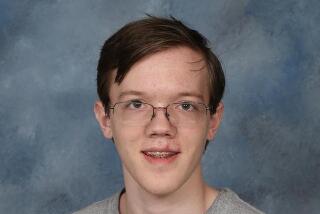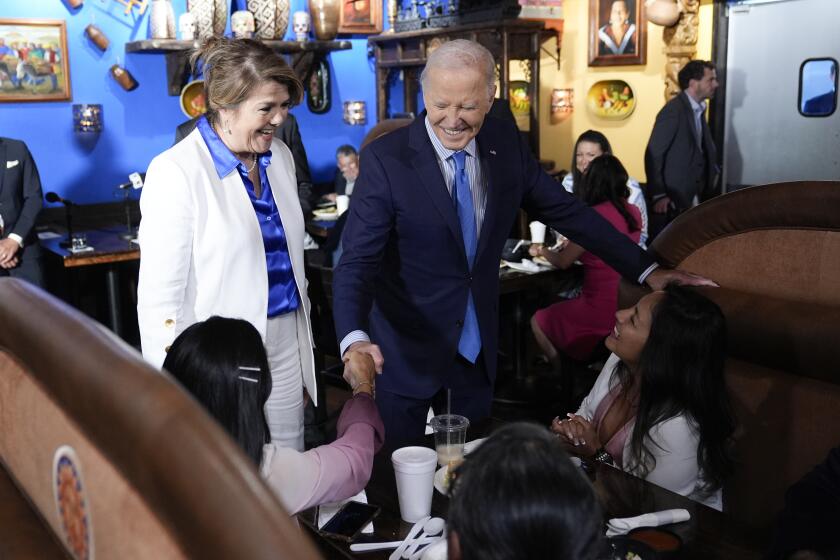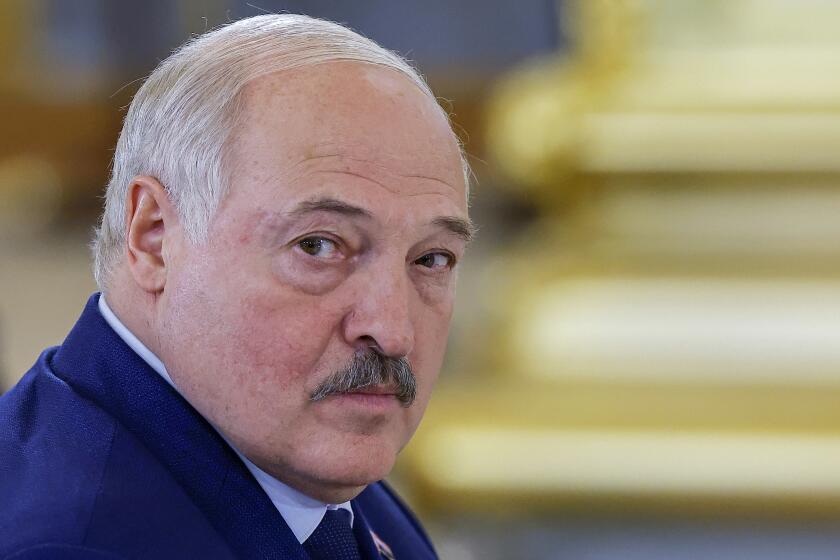Year After Disaster : Challenger’s Wake: Rage, Pain, Guilt
Today marks the first anniversary of Roger Boisjoly’s crippling rage. It was born in the angry fireball that consumed the space shuttle Challenger on Jan. 28, 1986, just 73 seconds into the heavens above Florida, and killed its seven crew members.
It didn’t have to happen. That’s what troubled Boisjoly. That’s what made him so angry he was unable to work at his job as a rocket engineer for Morton Thiokol, the company that made the massive booster rockets that had failed and destroyed the Challenger--the company whose vice presidents had ignored Boisjoly’s loud warnings that the launching would be too risky.
For a time, in the tragedy’s aftermath, the veteran engineer tried to vent his enormous anger in hard physical labor. He hauled away most of the big rocks in his mountainside backyard, a landscaping exercise requiring blood vessel-popping exertion.
He tried to wear himself out, hoping to achieve through exhaustion what the sedative his doctor prescribed couldn’t give him: a peaceful night’s sleep.
Fame Followed Crash
At the same time, Boisjoly’s frequent, blunt-spoken appearances at televised investigative hearings--usually alongside fellow engineers Allan McDonald, Arnold Thompson, Robert Ebeling and Brian Russell--made the bald New Englander a public figure, even a tragic hero of the shuttle drama.
And for that, there was an additional private cost: resentment on the part of those who had been hoping to avoid, at least in part, official blame. It came from corporate executives, and from the National Aeronautics and Space Administration, Morton Thiokol’s biggest customer. And it came from colleagues fearful that too much exposure of truth might hurt business and cost them their jobs.
“If you wreck this company, I’m gonna put my kids on your doorstep,” grumbled one. Someone finally dubbed the engineers “the five lepers.”
Disability Leave Granted
Last week, Boisjoly, who for a time after the accident suffered from headaches, numbness of one arm, chest pains and double vision, was granted a long-term disability leave. Ebeling has applied for stress-related disability benefits. And, at both NASA and Morton Thiokol there have been demotions, reassignments and early retirements--among the many other victims of the shuttle crash.
The story of Roger Boisjoly and his fellow rocket engineers is about some of those unseen other victims of Jan. 28, 1986. It is a story of broken careers and troubled lives, about haunting guilt and disabling fears, about life and death and living in hell.
The following account is based on the first public interviews with Boisjoly, 48, and his family, and on interviews in the past year with other Morton Thiokol engineers and managers, most of whom asked not to be identified:
Roger Boisjoly already was a seasoned engineer when a Turkish Airlines DC-10 crashed outside Paris in March, 1974, killing 346 people. That disaster also turned out to be an engineer’s nightmare: a design flaw in a cargo door was the cause. Someone had screwed up.
At the time, Boisjoly couldn’t give that much thought. He had a new job with the Rockwell Corp. in Downey, doing design stress analysis for the new shuttle orbiter crew module. But he couldn’t help noticing that a colleague came to work “in pretty bad shape.”
“One day he was walking around in a sort of stupor. I thought he was on drugs,” Boisjoly recalled.
He was, on tranquilizers. The troubled engineer had worked with a previous employer on a DC-10 design team, and he had fought for changes in the cargo door’s design. Now, he blamed himself for not pushing harder. He blamed himself for 346 bodies in a Paris woods.
Boisjoly noted that man’s private agony. He never forgot the image. It would return, as a ghost, in his own future.
Career Move to Utah
It was January, 1980, when Boisjoly decided he wanted to move his family to a quieter corner of the country. He clipped a Utah-shaped ad from the Los Angeles Times and applied for a job with Morton Thiokol, manufacturers of solid fuel booster rockets for the shuttle and a number of other missile systems.
It would mean a cut in pay for the middle-aged engineer, but with his wife, Roberta, and their two teen-aged daughters, Boisjoly left Southern California for the Wasatch Mountains. He planned to make it his last career move.
By early 1985, he was working on rocket seal problems with Arnie Thompson and Bob Ebeling. At that time--a full year before the Challenger’s last mission--the three engineers and others already were worried over fresh data that suggested poor performance of the rocket seals in low temperatures.
The alarm bells went off after booster rockets recovered from the Jan. 24, 1985, launching showed signs of seal erosion in 53-degree weather--until then the coldest conditions of any shuttle launch. NASA and Thiokol managers agreed that the discovery required prompt analysis.
Frustrations of Job
Boisjoly became frustrated early. Engineers assigned to the problem with the seals were still expected to keep up with their regular jobs. Requests for materials were being processed routinely, and that meant long delays. Boisjoly complained.
“Roger bitches constantly. He always wants us to do things his way,” groused one manager.
Boisjoly was beginning to see glimpses of a ghost: A chilling apparition of that DC-10 engineer.
On July 31, 1985, nearly six months after he had warned management at NASA and Thiokol about evidence of seal erosion, Boisjoly decided to quit waving his arms for attention and wrote a memo. In it he called for urgent action to prevent a “catastrophe of the highest order, loss of human life.” He gave one to his bosses. He put away a copy in his personal files.
In response to his memo, a rocket seal task force was named, but the frustrations of chronic procurement delays continued. If costly laboratory equipment was needed, for example, it could take months of paper work, bid comparisons and a chain of executive approvals.
‘No Skunk Works’
“The frustration was understandable, but this is no skunk works,” one Thiokol manager said. “It’s a big company now. That’s a big contract, and everybody was giving NASA hell about costs.”
Similar delays also plagued small orders. A $2,500 generator available from a warehouse in San Diego, for example, could have been shipped to Utah overnight. Instead, it took four weeks to process the purchase order.
Even Thompson--”ol’ optimistic Arnie,” as his friends called him--was beginning to grind his teeth at the delays. And Ebeling finally exploded with a less-than-delicate suggestion that Thiokol lock its gates and “stop shipping these pieces of ---- until we get them fixed.”
Sometime on the night of Jan. 27, 1986, Roger Boisjoly’s feeling of frustration turned to anger.
He and a team of engineers unanimously recommended postponing the shuttle launching because of the frigid conditions in Florida. But four Thiokol vice presidents, under pressure from NASA in a late-night telephone conference, overruled their top technical experts.
Boisjoly saw it coming. After listening to NASA executives challenge the reliability of their scientific data and complain that they were “appalled” at the recommendation for delay, Thiokol’s general manager, Jerry Mason, told his fellow vice presidents: “It’s time to take off your engineering hats and put on your management hats.”
“I knew they were going to change,” Boisjoly said. “I couldn’t believe it, but I knew it.”
Trying to head off the shift, Boisjoly raised his voice. Later, some would say that Boisjoly’s emotional approach actually worked against him. That he had made too many dire warnings and “waved his arms and rolled his eyes” too many times before. That he was like the boy who cried “Wolf!”
Photos of Damage
Boisjoly shrugs. “When you see a guy about to walk off a cliff you don’t whisper. You yell at him to move back,”
Boisjoly grabbed a set of photos showing seal erosion from the January, 1985, shuttle mission and “slapped them down, not gingerly” in front of the Thiokol executives.
“I said, ‘Look at the photos. How the hell can you ignore this? Look at the physical evidence.’ ” Instead, Boisjoly remembers, the vice presidents looked at each other.
That was when Arnie Thompson scooped up a note pad and squeezed between two of the executives. He tried to draw one more picture that might convince them where mere data had failed, a picture of a rocket joint with clevis and tang and O-rings and . . . He never finished.
“They weren’t listening,” he would confide to a colleague later.
The vote of the vice presidents was “Go.” Boisjoly didn’t really hear the poll. He was too angry--”angry in body and mind.”
Someone told him later that the last vote was cast by Robert Lund, the kindly and soft-spoken vice president of engineering. Others detected hesitation, even reluctance, but Lund’s vote had finally made it unanimous.
Icicles were forming on the Challenger pad in Florida. In Utah, Boisjoly and Thompson went home to their first sleepless night.
Through the magic of videotape, schoolteacher-astronaut Sharon Christa McAuliffe kept strolling across the nation’s television screens all morning as the launching time approached. Each time, she waved and smiled on her way to the shuttle crew module. But Thompson wasn’t watching. When liftoff finally came, he was in his office with another engineer, still reliving the frustration of the night before. And trying to ignore the feeling of dread.
“I couldn’t make them listen,” he kept saying. Although he wouldn’t watch the launching, he couldn’t avoid hearing the awful news.
Maybe more than any of them, Bob Ebeling had known tragedy. He actually had held it in his arms once, on the day his son committed suicide. Ebeling could only cradle the young man in his arms as he died--and wonder why he hadn’t done more to prevent it.
But on Jan. 28, 1986, the tragedy was on television, beyond the reach of even a final embrace. It was not, however, beyond that all-too-familiar sense of loss--and guilt. Ebeling recognized a brutal, heart-wrenching guilt he had known only once before. And again he wondered why he hadn’t done more to prevent it.
Feelings of Guilt
It wasn’t that Ebeling hadn’t tried to stop the launch. He had been one of the first to recommend delay. He’d left the debate to the experts, Boisjoly and Thompson--and McDonald out at the Cape. But none of that made the pain go away.
“How many times can you stand to feel responsible for something that goes wrong?” Ebeling agonized. “I should have been more boisterous. I should have said something more.”
Fortunately, perhaps, there was little time for anyone to ponder all the implications of the disaster. An investigation was under way almost instantly. Boisjoly and Thompson were dispatched to the Marshall Space Flight Center in Huntsville, Ala., where NASA would conduct its own probe.
Maybe there had been defective workmanship or defective equipment. Maybe something in the cargo hold had exploded. Maybe the big, rust-colored external tank had leaked. Maybe one of the main engines had thrown a rotor blade. Maybe a strand of hair had compromised a seal in the rocket booster. The maybes seemed infinite.
Most engineers and managers at Thiokol felt no sense of guilt--corporate or personal--in those first days after the Challenger crash. Most doubted that the solid rocket boosters should even be considered suspect. Most doubted that--but not Ebeling or Boisjoly or Thompson or McDonald or Russell.
Puts Finger on Problem
Just hours after the explosion, “ol’ optimistic Arnie” Thompson stood in a Thiokol office with stunned colleagues, all gathered to speculate about what went wrong. One of them recalls Thompson swiping a big, bony finger across a picture of a booster rocket joint and saying, sadly and certainly: “There. That’s where it failed.”
It’s not clear what startled his colleagues most, the fact that Thompson could presume to solve the mystery so quickly, or that he was pointing a finger right back at his own company.
The pre-launching dispute between management and the engineers might never have come to light, had the engineers kept silent. During the first closed session of the presidential commission investigating the crash, neither NASA executives nor Thiokol managers had given any hint of the emotional debate over the cold launch conditions or the engineers’ recommendation to wait.
The panel was about to adjourn when McDonald, who had sat silently until that moment, raised his hand. Al McDonald was never known for his diplomacy. Like any good engineer, he drew straight lines from Point A to Point B, and he was accustomed to speaking just as directly.
“He can be a real scratchy bastard,” said a longtime friend. “He rubs some people the wrong way. Hell, he could say ‘good morning’ in a way that could make some folks at NASA wanna take a punch at him.”
There figured to be a lot of clenched fists at NASA that day. McDonald’s message was plain: the engineers had warned NASA and their managers that it was unsafe to launch in the cold, but they had been overruled.
O-Rings and Judgment
In short, Challenger and its crew had been the victims of cold O-rings and bad judgment.
In subsequent days Boisjoly, Thompson, Ebeling and Russell also were called upon to give similar testimony. Thiokol was embarrassed. Its engineers were making its managers--and prime customer, NASA--look bad. NASA was furious.
The space agency’s own investigation of the Challenger crash seemed at times to focus on discrediting the cold-weather theory. An early NASA draft report spent only a few paragraphs on the affects of cold on rocket seals, but devoted several pages to other potential problems, including errors in the rocket assembly process that could have caused the failure.
But McDonald’s bombshell was followed by Boisjoly’s bombshell--the release of his private company memo of July 31, 1985, and other papers documenting a history of warnings and “red flags” over rocket seal problems.
It was clear to the engineers that NASA was bent on minimizing the pre-launch concern over the cold. Boisjoly was sufficiently concerned that he took his personal files into a sort of protective custody. He emptied his desk and took the critical memos with him to Huntsville. He slept with them in his motel room. He hid them in the locked trunk of his rented car when he went to work at the Marshall Space Flight Center. He sent copies home to Roberta. And still he worried that someone might try to lose or destroy them.
After he finally passed the files personally to Major Gen. Donald J. Kutyna of the presidential commission, Boisjoly was accused of “airing the company’s dirty laundry” in front of the whole country.
“They perceived me to be an exposer,” Boisjoly said, “but I felt like we were being pushed out on a plank. NASA was trying to discredit us. The company was treating us like black sheep. It got to be very personal, very uncomfortable.
“I’m ashamed to say it, but it got to where I wanted less to be proven right than for them to be proven wrong,” he conceded.
Although the presidential commission expressed admiration for “the courageous testimony” of Boisjoly, McDonald and the others, the engineers felt like men under siege back home.
It was a bad time for Thiokol all around. After the accident, the shuttle program stopped and about 200 engineers were temporarily laid off. Some feared it would be a long “temporary” layoff. Management officials were under fire, and those who didn’t take early retirement were demoted or reassigned to lesser positions.
Wife Is Accosted
Animosity festered in many quarters, and much of the blame was placed on the embarrassing testimony of the five engineers. One afternoon, Roberta Boisjoly was confronted by an engineer’s wife who shook her head and demanded: “Why are they saying all these things about Thiokol? Don’t they see the press is just twisting it all around? Everyone knows it couldn’t be our fault what happened.”
NASA’s irritation with McDonald and Boisjoly, in particular, finally resulted in their virtual isolation. Thiokol managers cut them off from dealing with the space agency.
Ebeling was systematically excluded from technical conferences that were once part of his duties. “They acted like I wasn’t needed anymore,” he said with a shrug.
Boisjoly and Brian Russell returned from brief vacations to find that managers had ignored some key technical advice about new rocket joints, and the mild, gentlemanly Russell angrily confronted his bosses, saying: “I guess I’ll go start writing my memos for 1988!”
Meanwhile, as reorganization radically changed Thiokol’s management lineup, Thompson, Russell and McDonald were passed over for promotions.
“A lot of people who didn’t have the courage to speak up got promoted,” observed one colleague of “the five lepers.”
Throughout the early months, Boisjoly refused to visit a psychiatric counseling clinic that Thiokol set up in Brigham City to help its employees cope with the trauma of the shuttle disaster.
“I was afraid it wouldn’t be confidential. I just didn’t trust the company,” Boisjoly said later. “I was afraid if I went they might try to use that to say, ‘hey, we told you those engineers were crazy.’ ”
Congress learned about Thiokol’s treatment of the engineers, and threatened to retaliate against the company. McDonald ultimately was promoted to director of Thiokol’s crash effort to redesign the booster rocket, and life improved for the others. But for Boisjoly, it came too late.
Roger Boisjoly didn’t notice the anger that raged within him. Not at first. Everyone else did--Roberta and the girls, Norma and Darlene--even the dog. He yelled at the dog. He yelled at his daughters. He raged at anything and anyone at the slightest provocation.
“We couldn’t even go for drives any more,” Roberta Boisjoly recalled. “If some driver cut us off, Roger would get furious. Before, maybe he’d mutter and complain, but now he would go after them. I mean, he’d aim the car and drive right at them! It was . . . it was . . . well, it wasn’t like Roger.”
Another clue was his waistline. Boisjoly, a confessed “nervous eater,” gained more than 40 pounds in about four months after the shuttle crash.
For months, he was obsessed with the rocket seal problem. He couldn’t sleep. He couldn’t talk about anything without coming around to the O-ring seals. He stopped going to church to avoid the crowds. He was starting to have headaches.
Double-Vision Episode
Other members of “the leper colony” made a habit of dropping by his office to check on Boisjoly’s condition. Sometimes they found him staring at the wall. Then came the numbness in his left arm, and tightness in his chest. One day at his desk, his eyesight failed. It was the sudden onset of double vision that frightened him into visiting the doctor.
His problem was diagnosed as stress-related. He finally sought counseling.
Last July, he put in his last full day at the plant. He had intended to return after a two-month rest, and after Darlene’s wedding in September. But the anger was like a disabling poison in his system. He applied for long-term disability, and the company granted it last Saturday.
For Bob Ebeling, 62, the crippling poison is fear. He wants no role in another space shuttle launching. He wants no responsibility that affects the lives of others.
“I couldn’t stand another malfunction that I had anything to do with,” Ebeling explained.
Bob Lund was the vice president who cast the final, reluctant vote to go ahead with the launching. His friends still worry about how he’s coping with the ordeal.
“Everyone seems to think all the engineers were the righteous good guys and all the vice presidents were evil bad guys,” complained a friend of Lund. “He made a mistake. A lot of people made mistakes.”
Another colleague said that Lund, who, like two of the other vice presidents, was reassigned outside the shuttle program--only now is starting to recover from “a year in hell.”
“He told me he thinks he’s going to live after all,” the colleague said. “At first, he said he wasn’t sure he’d survive. Then he said he wasn’t sure he wanted to. It’s sad.”
Boisjoly wonders if the ghost of Bob Lund might serve a future engineer in much the way that a distant DC-10 engineer served him--as a reminder of the cost of doing too little.
“What I’m afraid of is that some young engineers will see what happened to me and think it isn’t worth it to speak out, to take a stand,” Boisjoly said. “I’ve paid a price, but look at Bob Lund. He’s a decent guy who’s got to live the rest of his life knowing one of his decisions cost the lives of seven people. They all do.
“That’s a tragedy.”
Southern California students mark anniversary, Part V, Page 1.
More to Read
Start your day right
Sign up for Essential California for news, features and recommendations from the L.A. Times and beyond in your inbox six days a week.
You may occasionally receive promotional content from the Los Angeles Times.






